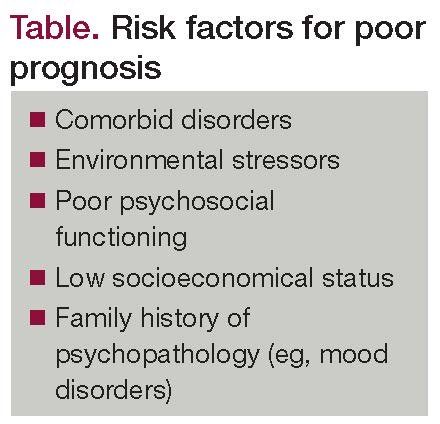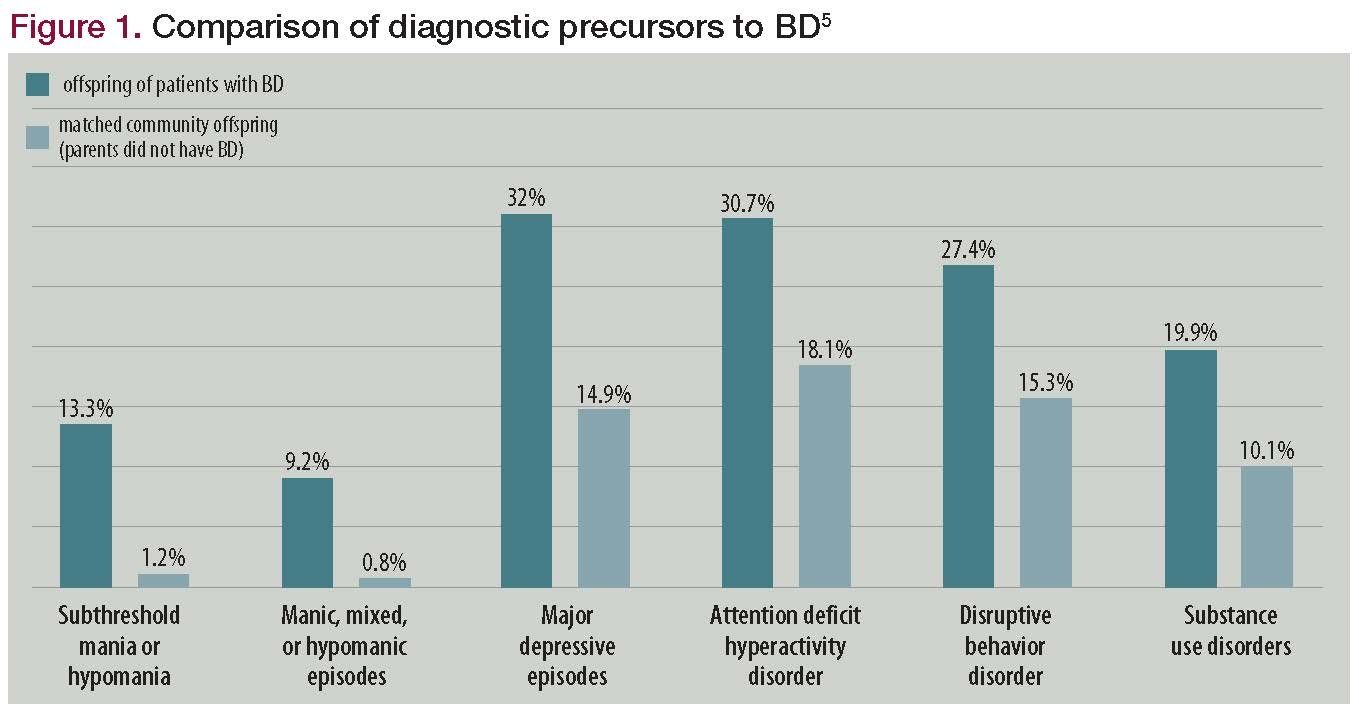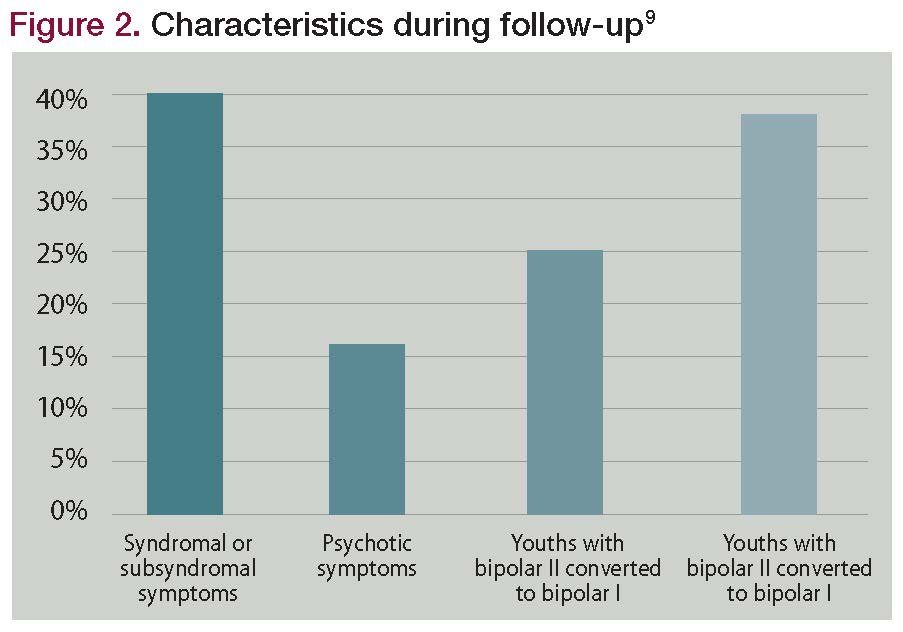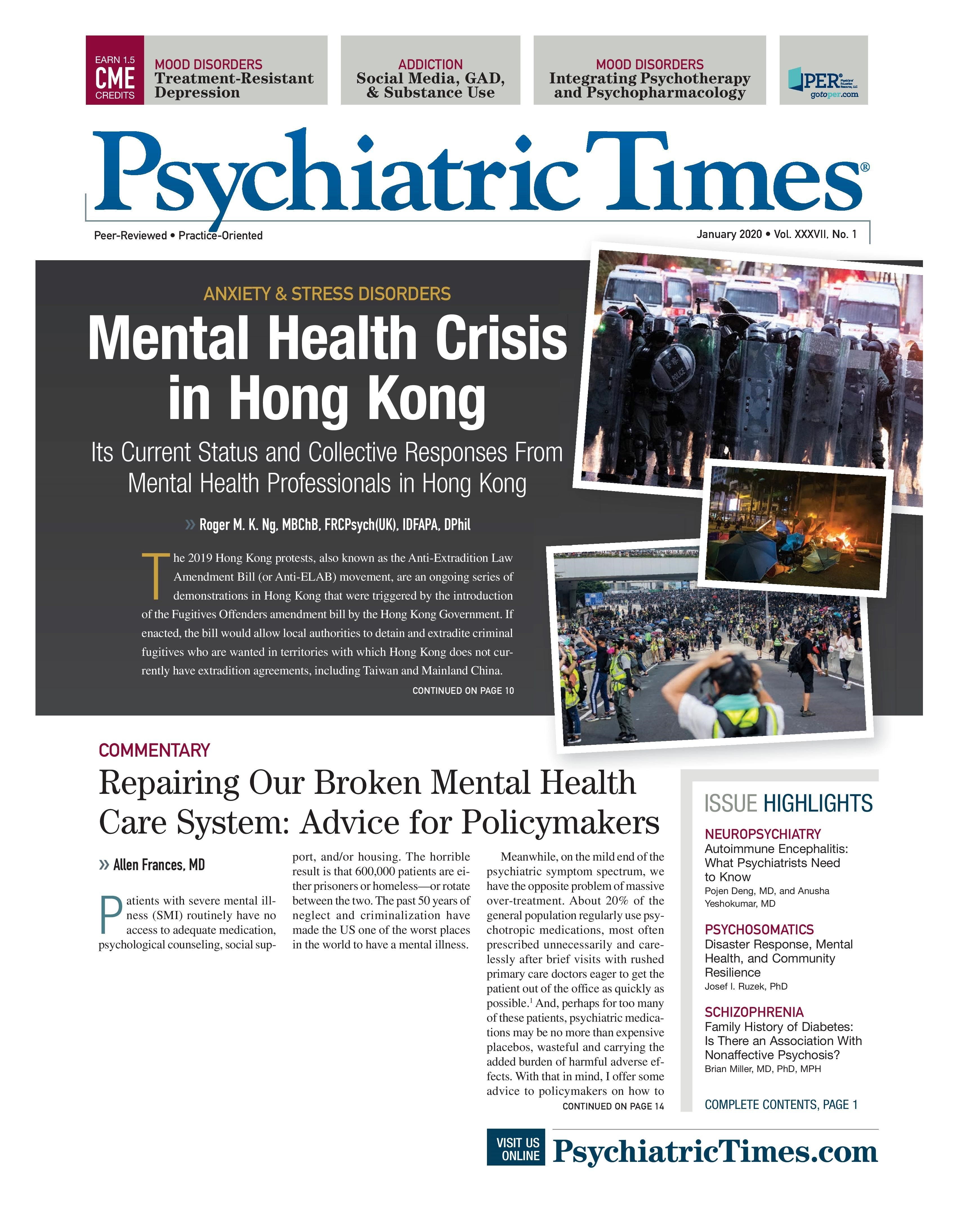Publication
Article
Psychiatric Times
Diagnostic and Treatment Challenges in Bipolar Disorder in Children and Adolescents
Author(s):
Just as the progress over recent decades has improved the clinical evaluation and management of BD among children and adolescents, the remaining gaps serve to inform future progress.

Table. Risk factors for poor prognosis

Figure 1. Comparison of diagnostic precursors to BD

Figure 2. Characteristics during follow-up

Mood problems can occur before puberty, with the prevalence more than doubling during and after puberty. Some of the mood problems will follow a bipolar course. The challenge is recognizing which patients have unipolar depression, and which are some form of bipolar disorder (BD).
Four variants of BD recognized in ICD and DSM:
1) BD-I requires at least one manic episode to establish the diagnosis; depressive and hypomanic episodes are optional from a diagnostic point of view, even though clinically they are the more common presentations.
2) BD-II requires a history of at least one major depressive episode and one hypomanic episode; the depressive episode is far more likely to come to clinical attention.
3) Cyclothymic disorder requires a year or more of hypomanic/manic symptoms and depressive or dysthymic symptoms, not rising to the level of full blown mania (otherwise the diagnosis is bipolar I) or major depression (which indicates bipolar II).
4) Other specified bipolar and related disorders are diagnosed by exclusion of the previous three. The diagnosis can include cases with hypomania in the absence of major depression, insufficient duration of episode, not quite enough symptoms to meet the formal definition, and brief (eg, approximately 6 months) cyclothymic presentations. Clinically, 2- or 3-day hypomanias are common, and do not appear to differ meaningfully from full-duration hypomania. Episodic presentation of symptoms is more suggestive of mood disorder than more chronic histories of the same symptoms.
Conducting the differential diagnosis
People are unlikely to seek help when hypomanic, and much more likely to seek services when depressed than when hypomanic. Thus, one major differential diagnosis is unipolar depression versus bipolar depression. Both depression and hypomania are associated with episodic irritable mood, especially in youths, so another set of differential diagnoses is BD versus disruptive behavior disorders, disruptive mood dysregulation disorder (DMDD) or ADHD. Note that the DMDD phenotype is common among youth with all BD subtypes; as such, identifying a discrete, episodic BD phenotype does not preclude a comorbid DMDD phenotype and vice versa.
Irritability is also pronounced in anxiety disorders and trauma. Cognitive debiasing strategies-including making multiple diagnostic hypotheses, forcing them to compete, and asking about lifetime history of hypomania and mania whenever treating for mood problems-improve the speed and accuracy of detection. More episodic changes that include discrete exacerbations of irritability, energy, and attention problems make the presentation more suggestive of a mood disorder than differential diagnoses with more chronic presentations.
Several checklists and rating scales have been validated in a range of clinical samples. A meta-analysis comparing the published contenders found three that are top-tier, separating cases with BD from clinically realistic comparison groups with good accuracy.1 Two of these: the Parent General Behavior Inventory-10 item Mania (PGBI-10M) and the Child Mania Rating Scale (CMRS) have one-page short forms available that preserve strong reliability and validity, and also good sensitivity to treatment effects.2,3 These also have been translated into several languages including Spanish. Copies of these are available at Wikiversity. These could be sent to patients ahead of the first evaluation or completed in the waiting room, and they are brief enough that they could be repeated to check for treatment response to adjust dosing.
There are also a variety of mood charting apps available for smartphones and online. Adolescent and young adult patients frequently like using these apps, and they can provide helpful information about course and treatment response as well as grist for psychotherapy sessions. (See Youngstrom, Morton, and Murray4 for a much more extensive review of assessment options.)
Prospective course and prediction
Thus far, the foremost risk factor for BD among children and adolescents is parental BD (Figure 1). In a large prospective study of offspring (6-18 years old at intake) of parents with BD, 23.6% had bipolar spectrum disorders.5,6 However, if a parent had early onset BD (eg, before age 21 years) and the offspring has significant symptoms of depression/anxiety, mood lability, and importantly, subsyndromal symptoms of mania, the risk for BD can increase up to 50%. The offspring’s risk for BD also increases if both parents have BD.7
These results pertain to the sample as a whole and not for a specific individual. To address this issue, mathematical tools (risk calculators) that integrate information about previous illness course and other factors associated with the outcome studied (eg, new onset of an illness, recurrence risk), yield a risk score that estimates the probability of outcomes for an individual. Risk calculators have been successfully developed and validated, and they are currently utilized as tools to enhance clinical decision-making across several health conditions (eg, cardiovascular disease, cancer).
Recently we developed a risk calculator to predict the individual risk for BD in offspring of parents with the disorder.8 Similar to other areas of medicine, these group-level findings have been bolstered by a risk calculator that yielded an accuracy of 76%. Nevertheless, the risk calculator requires external validation before it can be adopted in clinical practice. Offspring of BD parents often have additional psychiatric disorders and with exception of substance abuse, most of them manifest before the onset of BD.7 However, after adjusting for confounders (eg, parental non-BD psychopathology, socio- economic status, within family correlations), of all disorders only the presence of major depression and oppositional defiant disorder in the context of family history of BD are associated with increased risk for BD.
Related content: 4 Variants of Bipolar Disorder Recognized in ICD and DSM
A large prospective naturalistic showed that once BD develops, after a median of 124 weeks (BD-I:78.3 weeks, BD-II: 76.9 weeks, and BD-not otherwise specific [BD-NOS]:180 weeks), about 80% of the youths recovered from their index episode.9 However, about 40% experience a recurrence within 2 to 3 years. The primary differences in the course of BD among youths compared with adults with BD is more mixed presentations and more mood polarity changes (Figure 2). Youths are also at increased risk for suicidality, behavior problems, family conflicts, risk-related sexual behaviors, sexual and physical abuse, substance abuse and other disorders such as ADHD, obesity, and poor functioning. In addition, about 50% of youths with BD-NOS (ie, subsyndromal mania) convert into BD-I/II, especially if they have a family history of BD.10
Since the course of BD is heterogeneous, efforts have been made to determine whether there are subgroups of youth with BD with different mood trajectories. Indeed, a recent study showed four mood trajectories11:
• Mostly euthymic (~80% of follow-up time)
• Mostly symptomatic
• Intermediate prospective symptom burden
• Mostly symptomatic initially, but progressively improve and become mostly euthymic approximately 2 years into the illness.
Youths with more comorbid disorders, environmental stressors, poor psychosocial functioning, low socioeconomic status, and family history of psychopathology, including mood disorders, have worse prognosis (Table). Interestingly, in an average 9.4 years of follow-up study, about 24% of the youths (6-18 years old at intake) were euthymic 80% of the follow-up time.11 The results of this study raise the question, which needs to be investigated, whether all youth with BD should have lifetime pharmacological treatment.
This study appears to converge with prior epidemiologic findings of a putative developmentally limited form of child-adolescent BD, analogous to juvenile inflammatory arthritis. Similar to the individual-level prediction of BD among offspring of parents with BD, a risk calculator was recently developed to predict the 1 to 5 year risk for a mood recurrence with an accuracy of about 80%.12 While these calculators are publicly available, they require replication before being used in clinical practice.
Sorting through treatment strategies
The literature regarding treatment of children and adolescents with BD has accumulated substantially over the past 20 years, but progress has not been uniform across all aspects of BD. The most recent treatment guideline (2005) and practice parameter (2007) from the American Academy of Child and Adolescent Psychiatry predate much of the literature. The most recent CANMAT (Canadian Network for Mood and Anxiety Treatments) and NICE (National Institute for Health and Care Excellence) guidelines do, however, integrate recent literature.13,14
Mania. There are multiple first-line options for the treatment of acute manic/mixed episodes of BD-I, including lithium and several atypical antipsychotics (asenapine, aripiprazole, quetiapine, risperidone). Olanzapine and ziprasidone, although shown to exert antimanic effects in randomized controlled trials, are relegated to second-line treatment because of concerns regarding metabolic adverse effects and electrocardiographic changes, respectively.
How does one select among antimanics for a given youth? Current treatment guidelines highlight family history of treatment response as a factor to consider in treatment selection.13 Since most contemporary medications were not available a generation ago, this is most relevant to youth with a family history of lithium responsiveness. That said, many contemporary inpatient treatment settings do not enable the longer timeframe necessary to achieve control of mania with lithium compared with atypical antipsychotics. Within the atypical category, adverse-effect profiles and comorbidities can facilitate personalization of treatment. For example, some antipsychotics are considered to have more potent antipsychotic effects (eg, risperidone) than others (eg, quetiapine). The opposite pattern has been observed with treating comorbid anxiety disorders among adults with BD-quetiapine may be of particular benefit in this scenario. Although clinical experience supports similar observations, RCTs focused on these issues in youth BD have yet to be published.
Depression. In contrast to RCTs for acute mania, there are fewer gold-standard randomized controlled trials for the depressed phase of BD. Based on a recent RCT, lurasidone is the sole first-line treatment for pediatric bipolar depression. Lithium and lamotrigine are second-line options, based on promising open-label studies. Third line options include the olanzapine-fluoxetine combination, positioned as such because of metabolic concerns. Another third-line option is quetiapine; the two RCTs for pediatric bipolar depression have not been positive but have been constrained by limitations. Taken together with strong evidence from adult bipolar depression, quetiapine remains a reasonable option, particularly for youths with anxiety and/or insomnia.
Maintenance treatment. Few studies have examined maintenance treatment of BD, to prevent recurrences, and those studies that have are constrained by important limitations including low participant retention, small sample sizes, lack of focus on recurrence, and/or limited duration.15 There is also evidence of certain benefits of aripiprazole compared with placebo, such as greater likelihood of sustained continuation treatment, in youths with BD-I.16 The best continuation/maintenance study thus far found that adjunctive lamotrigine appears to extend time to any recurrence in adolescents-but not children-with BD.17
Pending long-term (ie, years) maintenance RCTs that mitigate the aforementioned limitations of prior studies, naturalistic data provide helpful insights that can inform treatment selection. Indeed, based on a recent large naturalistic study, lithium may be a leading option-as it is with adults.18 There have been recommendations of 12 to 24 months maintenance treatment post-mania, and post-discontinuation symptom monitoring for 2 years.14 However, there have not been studies that evaluated these important questions, and ultimately decisions are individualized.
Comorbid disorders. There are a number of studies that collectively support the conclusion that adjunctive stimulants for comorbid ADHD are efficacious, and thus far not associated with high rates of psychiatric adverse events such as mood destabilization. There are few data regarding pharmacotherapy for comorbid substance use disorders, and effectively no rigorous studies regarding comorbid anxiety. For these conditions, evidence-based skills-oriented therapy (whether individual or family-focused) is arguably the leading treatment approach.
Conclusion and future directions
Just as the progress over recent decades has improved the clinical evaluation and management of BD among children and adolescents, the remaining gaps serve to inform future progress. From an assessment perspective, validated screeners are not yet widely used strategically to streamline and triage more comprehensive assessments. From a diagnostic perspective, DSM and ICD are imperfect but adhering with the diagnostic symptom criteria is superior to a reliance on gestalts, intuition, and/or short cuts. Indeed, there are no reliable shortcuts, and accurate diagnosis of BD requires a comprehensive evaluation of contextual factors, comorbidities, and premorbid characteristics.
The validation of individual-level risk calculators is an imperative and would align pediatric BD with other branches of medicine. With regard to treatment, large scale prospective cohort studies and pharmacoepidemiologic studies, while not ideal, could yield important real-world evidence to inform ongoing treatment, particularly in relation to treatment scenarios with limited guidance from RCT-level evidence. Finally, the status quo of relying solely on observation and interviewing presents substantial obstacles. Readily available, clinically applicable objective markers, whether neurocognitive, brain-based, blood-based, or otherwise, are greatly needed.
Disclosures:
Dr Goldstein is Director, Centre for Youth Bipolar Disorder, Sunnybrook Health Science Centre; Professor, Departments of Psychiatry and Pharmacology, University of Toronto Faculty of Medicine. Dr Birmaher is Director, Child-Adolescent Bipolar Spectrum Services, University of Pittsburgh Medical Center; Distinguished Professor of Psychiatry, University of Pittsburgh School of Medicine. Dr Youngstrom is Professor, Department of Psychology and Neuroscience, University of North Carolina at Chapel Hill. Drs Goldstein and Youngstrom report no conflicts of interest concerning the subject matter of this article; Dr Birmaher reports that he receives royalties from Random House, UpToDate, and Lippincott, Williams, and Wilkins.
References:
1. Youngstrom EA, Genzlinger JE, Egerton GA, Van Meter AR. Multivariate meta-analysis of the discriminative validity of caregiver, youth, and teacher rating scales for pediatric bipolar disorder: mother knows best about mania. Arch Sci Psychol. 2015;3:112-137.
2. West AE, Celio CI, Henry DB, Pavuluri MN. Child Mania Rating Scale-Parent Version: a valid measure of symptom change due to pharmacotherapy. J Affect Disord. 2011;128:112-119.
3. Youngstrom EA, Zhao J, Mankoski R, et al. Clinical significance of treatment effects with aripiprazole versus placebo in a study of manic or mixed episodes associated with pediatric bipolar I disorder. J Child Adolesc Psychopharmacol. 2013;23:72-79.
4. Youngstrom EA, Morton E, Murray G. Bipolar disorder. Youngstrom EA, Prinstein MJ, Mash EJ, Barkley R, Eds. Assessment of Disorders in Childhood and Adolescence, 5th ed. New York, NY: Guilford Press; 2020.
5. Axelson D, Goldstein B, Goldstein, et al. Diagnostic precursors to bipolar disorder in offspring of parents with bipolar disorder: a longitudinal study. Am J Psychiatry. 2015;172:638-646.
6. Hafeman D, Merranko J, Axelson D, et al. Toward the definition of a bipolar prodrome: dimensional predictors of bipolar spectrum disorders in at-risk youths. Am J Psychiatry. 2016;173:695-704.
7. Goldstein BI, Shamseddeen W, Axelson DA, et al. Clinical, demographic, and familial correlates of bipolar spectrum disorders among offspring of parents with bipolar disorder. J Am Acad Child Adolesc Psychiatry. 2010;49:388-396.
8. Hafeman D, Merranko J, Goldstein T, et al. Assessment of a person-level risk calculator to predict new-onset bipolar spectrum disorder in youth at familial risk. JAMA Psychiatry. 2017;74:841-847.
9. Birmaher B, Axelson D, Goldstein B, et al. Four-year longitudinal course of children and adolescents with bipolar spectrum disorders: the Course and Outcome of Bipolar Youth (COBY) study. Am J Psychiatry. 2009;166:795-804.
10. Axelson DA, Birmaher B, Strober MA, et al. Course of subthreshold bipolar disorder in youth: diagnostic progression from bipolar disorder not otherwise specified. J Am Acad Child Adolesc Psychiatry. 2011;50:1001-1016.
11. Birmaher B, Gill MK, Axelson DA, et al. Longitudinal trajectories and associated baseline predictors in youths with bipolar spectrum disorders. Am J Psychiatry. 2014;171:990-999.
12. Birmaher B, Merranko JA, Gill MK, et al. Predicting personalized risk of mood recurrences in youths and ayoung adults with bipolar disorder. J Am Acad Child Adolesc Psychiatry. (In press).
13. Yatham LN, Kennedy SH, Parikh SV, et al. Canadian Network for Mood and Anxiety Treatments (CANMAT) and International Society for Bipolar Disorders (ISBD) 2018 guidelines for the management of patients with bipolar disorder. Bipolar Disord. 2018;20:97-170.
14. National Institute for Health and Care Excellence (NICE). Bipolar disorder: assessment and management clinical guideline. Clinical Guideline. 2014.
15. Goldstein BI, Birmaher B, Carlson GA, et al. The International Society for Bipolar Disorders Task Force report on pediatric bipolar disorder: knowledge to date and directions for future research. Bipolar Disord. 2017;19:524-543.
16. Findling RL, Correll CU, Nyilas M, et al. Aripiprazole for the treatment of pediatric bipolar I disorder: a 30-week, randomized, placebo-controlled study. Bipolar Disord. 2013;15:138-149.
17. Findling RL, Chang K, Robb A, et al. Adjunctive maintenance lamotrigine for pediatric bipolar I disorder: a placebo-controlled, randomized withdrawal study. J Am Acad Child Adolesc Psychiatry. 2015;54:1020-1031.
18. Hafeman DM, Rooks B, Merranko J, et al. Lithium versus other mood stabilizing medications in a longitudinal study of bipolar youth. J Am Acad Child Adolesc Psychiatry. July 29, 2019; Epub ahead of print.







